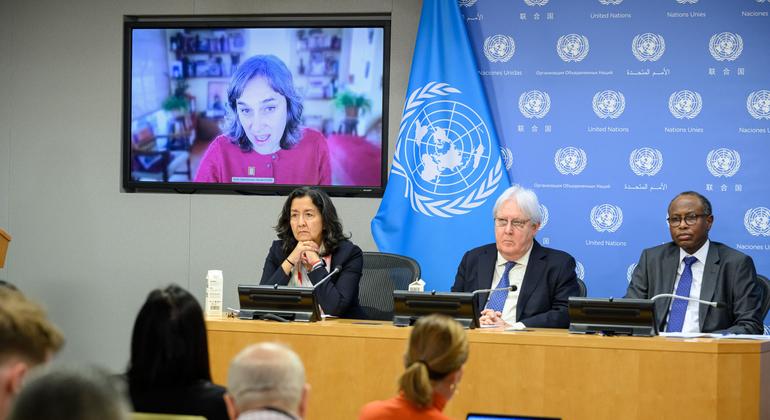
Since the ban, some 200, 000 ladies continue to attend secondary colleges in 12 provinces, plus women secondary school teachers continue to keep receive their salaries. The university or college ban, announced last 30 days, has further crushed their own hopes, said Omar Abdi, UNICEF Deputy Executive Movie director for Programmes. The officials reported on their mission to the country last week, in the wake of the edict prohibiting Afghan ladies from working with local plus international aid agencies, introduced on 24 December. The clinic’s staff also shared a horrific statistic, as 15 per cent of the children who seek help have problems with severe acute malnutrition.
A clear message
“Without women on this teams, we cannot offer humanitarian services to an incredible number of children and women, ” she said. Days later, the de facto Taliban authorities certified women to continue working in healthcare. “So, let there be no ambiguity. Tying the particular hands of NGOs simply by barring women from giving life-saving support to other females will cost lifestyles , ” she stated, speaking from Kabul. “We’ve made it very clear that humanitarian aid must never be conditional , and this cannot discriminate , ” said Ms. Soeripto. “We were not there to politicize aid. We can not do this work without females in all aspects of our worth chains. ”
Women’s vital role
“As lengthy as communities continue to demand education, we must continue to assistance both public and other forms of education, community-based classrooms, catch-up classes and vocational schooling. ” Three years of drought-like conditions, economic decline, and the influences of four decades of conflict, have left roughly two-thirds of the population, 28 million people, dependent on aid, along with six million on the edge of starvation. “Everybody offers opinions as to whether it’s going to work or not. The view is that the message offers clearly been delivered: that women are central, essential workers within the humanitarian sector , along with having rights, and we need to see them back to function. ” More than one million Afghan ladies have lost out on learning because of the order banning them from secondary school, which has added to losses sustained during the COVID-19 pandemic. “I’m somebody who doesn’t like to speculate too much, because it is a matter of rumours. Let’s see if these types of guidelines do come via. Let’s see if they are helpful. Let’s see what space there is for the essential plus central role of women within our humanitarian operations, ” this individual said.
Lives at risk
They were told that guidelines are being developed, and were asked to be patient, said Martin Griffiths, UN relief chief and the IASC chair, speaking during a press conference at EL Headquarters. The IASC objective visited a clinic at the outskirts of the capital, Kabul, run by the UN Children’s Fund ( UNICEF ) and a local partner. Symbolizing the Inter-Agency Standing Panel ( IASC ), they stressed the fact that world’s largest humanitarian operation – supporting some twenty-eight million people in Afghanistan – simply cannot function with out women staff. Women comprise 30 per cent from the 55, 000 Afghan nationals working for NGOs in the country, according to Janti Soeripto, President plus Chief Executive Officer of Save the Children.
Services restored
Critical health and nutrition providers there are up and running again since women staff are back on board, said Sofía Sprechmann Sineiro, Secretary General of CARE International. In their meetings with the Taliban, the IASC mission expressed opposition to the ban, which they hoped would be rescinded, and advocated just for exemptions in all aspects of humanitarian action. The loss of these types of valuable workers also comes as Afghanistan is facing the coldest winter in 15 years, with temperatures dropping to nearly -30 degrees Celsius, resulting in numerous deaths. “The officials we fulfilled in Kabul…reaffirmed that they are not really against girls learning within secondary schools, and once again promised to re-open after the guidelines are approved by their own leader, ” he stated.
Huge learning loss
In addition, many women aid workers are usually themselves the sole breadwinners for his or her families, which means many more families will go wanting. Meanwhile, the number of community-based education classes in private homes and other locations has doubled to 20, 000 over the past year, serving several 600, 000 children, over fifty percent of them girls. During their meetings with the de facto authorities, the humanitarian education chiefs also pushed for your full inclusion of women and women in public lifetime. Humanitarians will require . 6 billion to fund their activities in Afghanistan this year.
Space for hope
“We won’t be able to identify their needs; communicate to feminine heads of households, which there are many in Afghanistan after years and years of conflict, and also to do so in a safe and culturally appropriate way . ” “These positive signs are the results of both the commitment from the de facto authorities and pressure from local communities to maintain schools and community universities open, ” said Mister. Abdi. A similar exemption was made in education, even though focused on the primary level as Afghan girls and females have been barred from attending high school and university. “We are very concerned about girls’ and women’s development and particularly their psychological health . In 2023, if secondary school training remains closed, an estimated 215, 000 girls who went to grade six last year will once again be denied the perfect to learn, ” he mentioned. Despite the bleak view, Mr. Abdi pointed to a few positive signs.